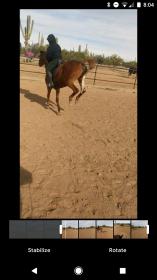My older mare is the type of smart, quick-thinking, high energy tryer who makes people love chestnut mares when they are on your side. 
She found changes easy, and is super confirmed in a straight line. We have done some single changes from half pass as well, with some anticipation moments which were easily fixed. Yesterday, we did canter zig zags and they went well.
Today, she had time to think about yesterday, and instead half passes turned into her flinging her whole body sideways against my outside leg to try to change bend when she thought I would probably be asking her to straighten then change. :lol: She is truly attempting to be helpful, and my understanding is this is a pretty common, normal phase to have happen. We also ended up with some ugly flip flops as she’d fling herself to one lead, realize I was still in position for the first lead, and switch back. :lol:
Today, I just rode through what amounted to bucking despite not being intended that way, asked her to go straight, counter canter, diagonal to true canter, and only change when she was not trying to anticipate it on a straight line so she had no reason to pretzel. I also did a lot of hands forward in half pass, which seemed to tell her there was no aiding of any sort going on, so just chill, and she anticipated much less then.
I think we’re on the right track and with time it’ll all calm down, but wanted to get experiences and advice in case there are any helpful tips besides give it time. 
edit: example below of her basically trying to fling her hind end around that leads to us revisiting basics so she doesn’t think she needs to “help.”
[ATTACH=JSON]{“data-align”:“none”,“data-size”:“medium”,“data-attachmentid”:10308233}[/ATTACH]

